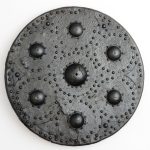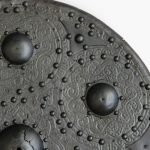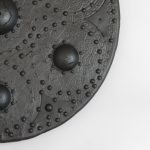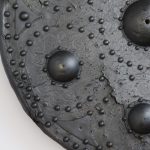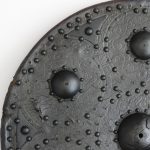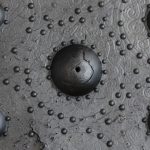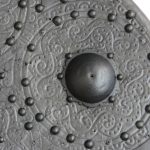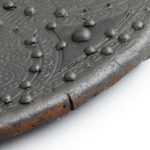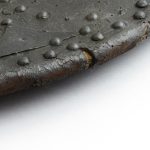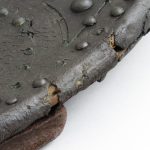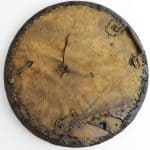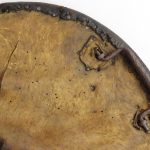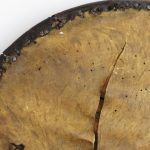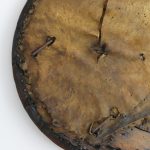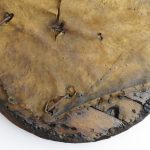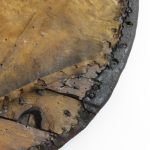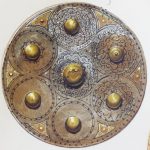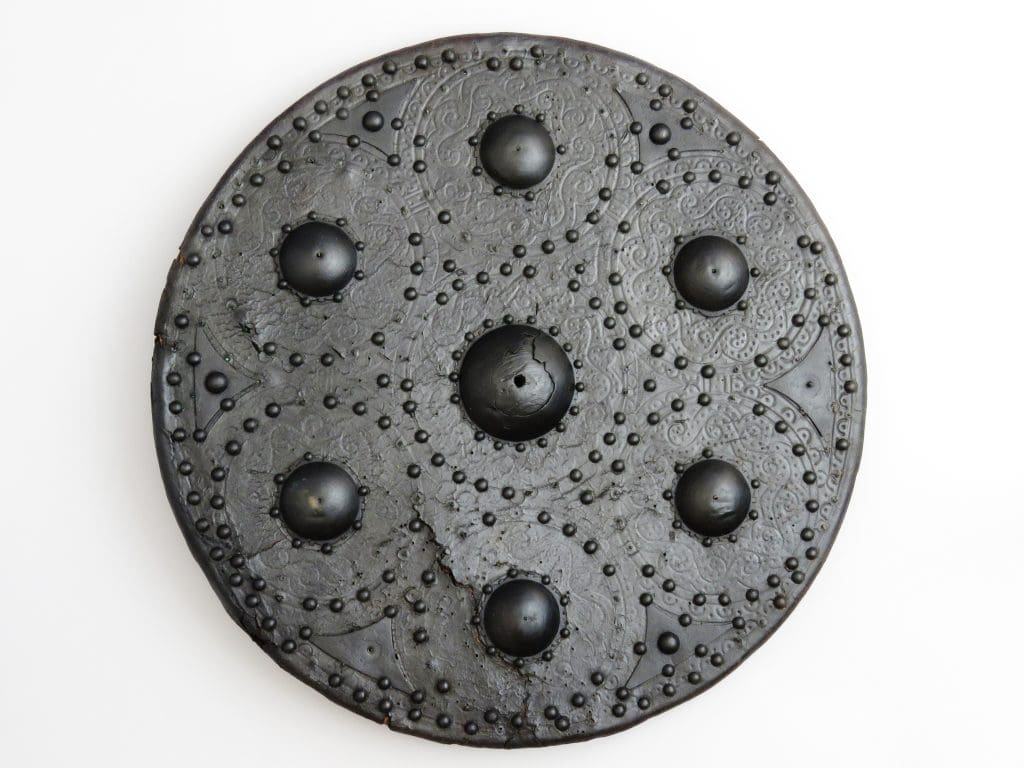
A Scottish Highland Targe dating to the Early 18th Century
To enquire about this itemplease click here
Price: £ POA
Ref: AA.034.20
Item Description
Targes are shields which were an important item of Scottish clan weaponry. They were used in substantial numbers from the late 16th century until the middle of the 18th when weapons were banned in the Highlands by the Disarming Acts enforced by the British Government after the failure of the last Jacobite Rebellion in 1745. After this clans ceased to function as independent military organisations.
Targes were effectively used at close quarters in conjunction with basket hilted swords and dirks by Highlanders in skirmishes and particularly in the battle tactic that became known as the “Highland Charge”. Constructed from wood and leather, targes in general have not survived the rigours of time in the Scottish climate as well as other traditional Scottish weapons made of iron and steel. Genuine “period” targes dating to before the mid-18th century are now very rare. The leather which covers the front of the targe has been radiocarbon dated. The result shows with certainty that it dates to the early 18th century.
The targe is a typical example of Highland craftsmanship. It is illustrated in James Drummond’s “Ancient Scottish Weapons” published by George Waterston & Sons, Edinburgh in 1881, plate 2 fig 3. Please see the last image in the sequence below for a photograph of the illustration in the book. This series of watercolours by Drummond did much to bring the uniqueness and aesthetic appeal of traditional Scottish weapons to the public eye at a time when collectors were interested in them but when little objective research had been undertaken. Some of the illustrations are of weapons with provenance from various private collections of the time and from the National Museum of Scotland, then called the National Museum of Antiquities, in Edinburgh. The design to the front of every surviving targe is unique in one way or another. The damaged central boss, the conjoined roundels, style of tooled interlace and the circular designs cut into the brass plates and bosses show that this is the same targe as that illustrated by Drummond. The targe is also very similar in construction and design to another targe in the Burrell Collection in Glasgow to the degree that both seem to have been made by the same maker.
Typically the targe is formed in the traditional manner with a circular base of cross-plied hand-cut pieces of wooden board held together with iron nails and wooden pegs. The front is covered with a single piece of leather which is folded over the bevelled edge and secured at the back with a large quantity of small hand-made iron nails around the rim. The leather at the front is tooled with traditional Gaelic designs of roundels and interlaced scrolls enhanced with patterns of brass dome-headed nails and bosses. These features mark out the targe not only as a weapon but also as an example of Highland Gaelic art of which very little has come down to us.
The centre of the targe at the front features a dome of wood covered with a brass boss with a flattened brim cut with merlons and crescents at the edge similar in style to the fretted edges to the guard panels of contemporary Scottish basket hilted swords. The dome is pierced in the middle to originally fit a spike which is now missing. The boss is fractured in the middle with a part of the brass missing revealing the wooden core beneath. The boss is surrounded by a roundel tooled into the leather with its edge accentuated by larger brass dome-headed nails applied between two concentric circles. The central roundel is surrounded by six slightly smaller ones with smaller bosses in the middle. The edge of the targe is applied with nails all around the circumference. The spaces between the six outer roundels towards the edge are filled with triangles of brass sheet centred with a brass dome.
The back is covered with a sheet of deerskin. The edge is fixed underneath the rim of the leather sheet folded over from the front and is secured to the wooden base by the same nails. The iron hinged grip for the hand remains together with the iron mounts for fixing the forearm strap which is now absent. It appears that a portion of the leather backing at some time was torn away to expose the wooden boards. This missing portion was replaced with a small piece which was nailed onto the targe to fill the gap. This leather is of a different more delicate type and had become detached when the targe was made available for sale. Due to its fragile state it is now stored separately.
The amount of work and artistic skill required to make a targe of this type is easy to underestimate. The tooling of the leather is an art form in itself. In its original state the targe front was mounted with 378 separate pieces of hand made brass work of which circa 75% remain. Clearly this amount of work meant that elaborate targes like this were a valued possession for the owner, not only as a weapon, but also as an expression of standing in clan society.
The most proficient warriors in clan society that carried targes of this type were known as “front rank” men, those that made first contact with the enemy in battle. This was a position of honour and an opportunity to display individual bravery. However, the privilege left them disproportionately exposed to the first volley from enemy infantry muskets. At the Battle of Killiecrankie in the 1689 Jacobite Rising, despite being outnumbered, the Highlanders charged the Redcoat lines, and when breached the Redcoats stood no chance against the ferocity of the Highlanders and their hand-to-hand close-in fighting skills armed with sword and targe. However, this was an expensive victory. Many of the best clansmen were killed in the first rush of the charge by a musket volley including John Graham of Claverhouse, “Bonnie Dundee”, the Jacobite army leader, which seriously marred the campaign from then on.
Records indicate that the Highland Charge was executed on ground chosen for a downhill rush over a short distance. Highlanders would tempt the enemy to discharge their firearms first, then rush closer to discharge their own, after which the opposition would be attacked before they could reload. It seems that Highlanders would run keeping a low profile covering their heads and upper bodies with their targes held at an angle. Held flat to a musket ball a targe in most cases would not stop it but held at an angle they were capable of deflecting one. Targes were used on first contact to sweep bayonets out of the way then engage with swords. Once lines were broken the Highlanders chased down and mercilessly dealt with any retreating opposition they could overtake.
Fine-tuned in the Civil War period in Scotland and Ireland the Highland Charge was a terrifying prospect for Lowland levies. Even experienced soldiers that had campaigned on the continent were not prepared for this level of face to face savagery once lines were breached. This ferocity had been forged historically in clan warfare, where the objective was often to completely exterminate all of the opposition. To government troops on service in Scotland the targe was a reminder that their muskets did not reign supreme. However, as the government stranglehold on the Highlands increased as the 18th century progressed the people of the region became increasingly weakened and vulnerable.
The targe did not just represent an anti-government stance. They were used by troops recruited in the Highlands for government service in regiments such as the Black Watch. An illustration entitled “Highlanders on the march in Flanders” dated 1743 shows some troops armed with muskets and others with swords and targes (1).
The decoration on targes differed on a regional basis and changed over time although the core construction method was generally the same. Some targes depicted in early 18th century portraits are shown with a spike mounted in the middle of the central boss. Only one targe known today is still with its original steel spike (2). The spike screws into the central boss. When the targe was not in use the mounted spike would be a cumbersome feature. As a result, on a day to day basis, it was stored in a leather sheath nailed to the back. Some other existing targes, including ours, show evidence that they were manufactured for mounting with a spike. The wooden boss is drilled with a narrow hole into which a round-section spike would tightly fit and screw into a threaded metal plate which lies underneath the boss. Some targes which have lost their spikes retain a brass stud or other feature screwed into the boss. This was intended to protect the aperture from debris and damage, and for aesthetic reasons, when the targe was not mounted with its spike.
Overall the Targe is in fair condition and similar in this respect to the better preserved 50% of its surviving contemporaries. The leather to the front is flaky and cracked in parts. Over time leather shrinks faster than wood and typically the leather on the front of this targe has shrunk around the rim pulling the edge away in places from the nails at the back which secure it. Around the edge the leather has split in a few small places revealing the bevelled cross-plied boards beneath. The thinner leather which forms the backing has shrunk more than the thicker cover at the front and has pulled away from the nails for one half of its circumference. The leather backing on many surviving targes is often absent presumably because it has become completely detached due to shrinkage and been disposed of at some time. The iron mounts of this targe are rusted, the hand grip is fused into its hinges and immobile. The leather to the front and the brass mounts are uniformly blackened with age. The diameter of the targe is 18.5 inches (47 cm).
- For further information on Scottish targes see Jackie Moran, “The Swords and the Sorrows”, National Trust for Scotland, 1996, pages 55 to 59, for a paper entitled “Highland Targes”.
- Also see the “Scottish Art Review Special Number”, 1963, pages 2 to 5, for a paper by Stuart Maxwell entitled “The Highland Targe”
